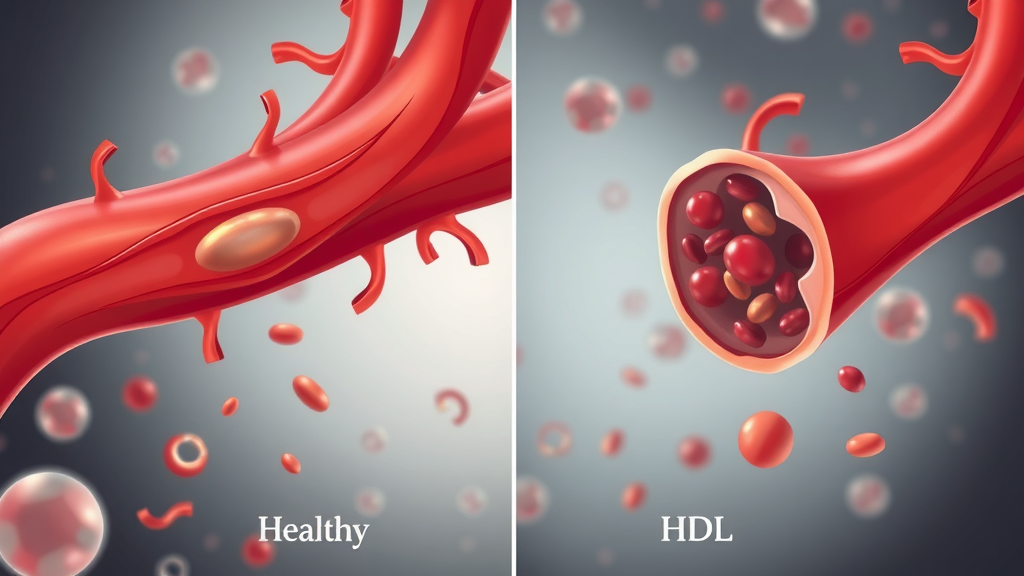Did you know nearly 95 million American adults have high cholesterol? Learning how to lower cholesterol quickly isn’t just about diet; avoiding common mistakes can dramatically improve your heart health and longevity. Discover effective strategies that can make a real difference—starting today.
The Importance of Knowing How to Lower Cholesterol for Heart Health
“Did you know nearly 95 million American adults have high cholesterol? Learning how to lower cholesterol quickly isn’t just about diet; avoiding common mistakes can dramatically improve your heart health and longevity.” – Opening Insight

High Cholesterol as a Risk Factor for Heart Attack and Cardiovascular Risk
High cholesterol is a significant risk factor for heart attack and other serious cardiovascular conditions, making it crucial to manage for optimal heart health. Elevated cholesterol levels, especially high LDL cholesterol, are directly linked to a higher risk of heart attacks and strokes, underscoring the importance of heart health management.
The Centers for Disease Control and Prevention warn that high cholesterol can cause fatty deposits to build up in your blood vessels, restricting blood flow and raising the risk of heart disease and related heart attacks. What’s crucial to understand is that heart attack and stroke risk elevates in those with untreated high cholesterol—often without any immediate symptoms.
Taking proactive steps to learn how to lower cholesterol effectively reduces your risk of heart attack, enhances heart health, and supports a longer, healthier life. Additionally, knowing your numbers and working towards optimal cholesterol levels with your healthcare provider can give you an actionable plan before you ever experience warning signs of heart disease. This ongoing strategy for heart health is critical—especially given that lifestyle changes are often the first recommendation for those at increased cardiovascular risk.
Understanding Cholesterol: What You Need to Know to Lower Cholesterol Fast
Types of Cholesterol: LDL, HDL, and Triglycerides

Cholesterol is a waxy substance necessary for various bodily functions, but not all cholesterol is created equal. The main types include LDL (low-density lipoprotein), HDL (high-density lipoprotein), and triglycerides. LDL cholesterol, often called “bad cholesterol,” can accumulate in arterial walls and contribute to the risk of heart attack and stroke. Lowering LDL is imperative for managing heart attack risk and boosting cardiovascular health. HDL, or “good cholesterol,” helps carry excess cholesterol away from the arteries and back to the liver, where it can be removed from the body. Higher HDL levels are associated with a lower risk of heart attack. Triglycerides, another type of fat in your blood, can also raise the risk factors for both heart attack and stroke—and should be managed alongside LDL and HDL for optimal heart health.
Understanding the differences between these types of cholesterol arms you with critical knowledge to effectively lower LDL and increase HDL. When you know which numbers to target and why, you can tailor your diet, exercise, and lifestyle habits to keep your cholesterol levels in check, thus reducing overall cardiovascular risk.
For a deeper look at how your heart’s performance is influenced by more than just cholesterol, it’s helpful to understand the role of your resting heart rate. Monitoring this simple metric can provide early clues about your cardiovascular health and help you fine-tune your approach to lowering cholesterol.
Explore what your resting heart rate reveals about your heart health for additional insights that complement your cholesterol-lowering efforts.
How High Cholesterol Impacts Heart Health and Heart Attacks
High cholesterol is a leading risk factor for heart disease, heart attacks, and strokes, making cholesterol control vital for maintaining heart health. Elevated LDL cholesterol levels promote plaque buildup inside blood vessels, narrowing arteries and restricting blood flow to the heart, which increases the risk of heart attacks and other cardiovascular events. This process, called atherosclerosis, can have deadly consequences if left untreated, significantly increasing the risk of heart attacks or sudden cardiac events. Even individuals who feel healthy can have high cholesterol and not realize the danger—another reason why regular cholesterol level checks are vital.
The impact is cumulative: over time, poorly managed cholesterol levels contribute not just to heart attacks, but wider heart health problems like angina, arrhythmia, and even heart failure. By learning how to lower cholesterol fast and avoiding common pitfalls, you actively protect your heart and vascular system—which is crucial for both immediate well-being and long-term health span.
Why Cardiovascular Risk Increases with Poor Cholesterol Management
When cholesterol management is neglected, cardiovascular risk rises sharply because arteries become less capable of carrying oxygen-rich blood to vital organs. Each increment in LDL cholesterol, or drop in HDL cholesterol, correlates with a higher risk of heart attack and stroke.
Equally, untreated high triglycerides can worsen arterial inflammation, compounding the overall risk. The American Heart Association notes that every step to lower cholesterol, from adjusting diet to increasing physical activity, can dramatically lower the odds of severe cardiovascular events.
It's essential to remember that lowered cholesterol isn’t only about preventing heart attacks; it’s about reducing the cumulative risk for all forms of heart disease and ensuring longevity. Committing to understanding and managing cholesterol levels means you're setting yourself up for a healthier, longer life—a compelling reason to make cholesterol control a priority.
Common Mistakes That Hinder Efforts When Learning How to Lower Cholesterol Fast
Relying solely on medication without lifestyle changes
Ignoring saturated and trans fats
Not monitoring cholesterol levels regularly
Overlooking hidden dietary sources of high cholesterol
Misunderstanding the role of exercise

Many people make critical mistakes when trying to lower their cholesterol quickly, which can inadvertently increase their risk factor for heart attacks and compromise heart health. One widespread error is relying exclusively on medication while neglecting crucial lifestyle changes. Statins and other cholesterol-lowering drugs are effective, but their benefits are optimized when coupled with dietary adjustments, regular physical activity, and consistent medical monitoring. Ignoring saturated fats and hidden trans fats in processed foods can undermine cholesterol-lowering efforts, as these dietary factors raise LDL cholesterol—the “bad cholesterol” that increases heart attack risk and damages heart health.
Another common oversight is failing to routinely monitor cholesterol levels. Without frequent testing, it’s difficult to tell if your efforts to lower cholesterol are working or if your risk factors are increasing. Overlooking hidden sources of cholesterol (like processed meats, certain bakery products, or full-fat dairy) can render your efforts incomplete.
And, finally, many underestimate the importance of regular and vigorous exercise. Not understanding how physical activity changes lipid profiles means missing out on a proven way to lower LDL and raise HDL—an essential part of any effective cholesterol management strategy.
Best Practices: How to Lower Cholesterol Fast with Lifestyle Changes
Dietary Adjustments That Enhance Heart Health
“Moderating saturated fat and increasing fiber intake can significantly impact cholesterol numbers in just a few weeks.” – Cardiology Expert

A heart-healthy diet is fundamental for those asking how to lower cholesterol fast. The American Heart Association recommends reducing saturated fat (found in fatty meats, full-fat dairy, and many processed foods) to cut LDL cholesterol. Increased fiber intake, especially soluble fiber found in oats, beans, and many fruits, can bind to cholesterol in the digestive system and help flush it from your body. Prioritizing unsaturated fats—for example, from fatty fish, nuts, and olive oil—can not only help lower LDL but also raise HDL cholesterol, the protective “good cholesterol.”
Beyond fats and fibers, consider the types of protein you consume. Replace red meats and processed meats that often hide sources of saturated fats with plant-based proteins and fish high in omega-3s, such as salmon or tuna. Consistent, incremental dietary shifts—like adding a serving of legumes to meals or swapping refined grains for whole grains—are shown to lower cholesterol levels in just weeks, leading to measurable improvements in heart health and cardiovascular risk reduction.
Exercise and Physical Activity to Reduce Heart Attack Risk

Physical activity is one of the most effective ways to support heart health and lower cholesterol fast, reducing the risk of heart attacks and improving overall cardiovascular function. The Centers for Disease Control and Prevention recommend at least 150 minutes of moderate aerobic exercise or 75 minutes of vigorous activity per week. Regular movement helps lower LDL cholesterol while simultaneously boosting HDL cholesterol, thus creating a more favorable lipid profile. Exercise reduces the risk of heart attacks, improves blood pressure, and can reduce triglycerides—key for those with high cholesterol.
You don’t have to be an athlete to see benefits. Even brisk walking, cycling, and active hobbies contribute to positive changes. Exercise also assists in weight management, lowers overall cardiovascular risk, and helps increase insulin sensitivity, providing additional protection against diabetes—a risk factor frequently associated with high cholesterol and heart attacks. Incorporate both aerobic exercise and resistance training to maximize your heart health dividends.
Managing Stress and Sleep for Cardiovascular Risk Reduction
Managing chronic stress and ensuring restorative sleep are often overlooked, yet they play essential roles in how to lower cholesterol fast. Chronic stress can increase your body's cholesterol production and leave you susceptible to unhealthy dietary habits, such as consuming more saturated fat or processed foods. Moreover, stress-related cortisol spikes are linked to increased triglycerides and greater cardiovascular risk. Strategies like mindfulness, yoga, regular downtime, and time spent in nature are proven to help lower stress and, subsequently, support lower cholesterol levels.
Restful sleep (at least 7–8 hours per night for adults) is another critical component. Sleep deprivation has been associated with higher LDL (bad cholesterol) and increased risk factors for heart attack and stroke. Creating a regular sleep routine, reducing screen time before bed, and prioritizing a calm sleep environment can help regulate your body’s stress response, improve lipid profiles, and decrease your risk of cardiovascular events.
How to Lower Cholesterol Fast: Foods to Eat and Avoid
Top foods to lower cholesterol: oats, nuts, fatty fish, legumes, and leafy greens
-
Foods to avoid: processed meats, full-fat dairy, fried foods, and baked goods rich in trans fats
Comparison of Foods That Lower vs. Raise Cholesterol
Type of Food |
LDL Impact |
HDL Impact |
Examples |
|---|---|---|---|
Oats & Whole Grains |
↓ Lowers LDL |
↔ No change or slight ↑ |
Oatmeal, barley, quinoa |
Nuts & Seeds |
↓ Lowers LDL |
↑ Raises HDL |
Walnuts, almonds, flaxseed |
Fatty Fish (Omega-3s) |
↓ Lowers LDL & triglycerides |
↑ Raises HDL |
Salmon, sardines, mackerel |
Leafy Greens |
↓ Lowers LDL |
↔ No change |
Spinach, kale, arugula |
Processed Meats |
↑ Raises LDL |
↓ May lower HDL |
Sausage, bacon, deli meats |
Full-Fat Dairy |
↑ Raises LDL |
↓ May lower HDL |
Whole milk, cheese, butter |
Fried Foods/Trans Fats |
↑↑ Greatly raises LDL |
↓↓ Lowers HDL |
French fries, pastries, processed snacks |

Your food choices directly influence your cholesterol profile. Focus on consuming more whole grains like oats—which contain beta-glucan, a soluble fiber known to help lower cholesterol—and nuts, which provide healthy fats and antioxidants. Fatty fish like salmon and mackerel offer omega-3 fatty acids that lower LDL and triglycerides while helping to raise HDL. Leafy greens add fiber and important micronutrients.
Conversely, processed meats, full-fat dairy, and fried foods are notorious for containing saturated fat and trans fats, which can dramatically raise LDL and suppress HDL, raising your risk for heart attack and cardiovascular disease. By consciously selecting foods from the “lower cholesterol” categories, you create sustainable habits for long-term heart health.
How to Lower Cholesterol Fast: The Role of Medication and Medical Advice
When Medication is Necessary for High Cholesterol

While lifestyle changes play a starring role in lowering cholesterol, sometimes medication becomes necessary. If your cholesterol levels remain high despite implementing dietary and exercise changes, or if your personal or family history puts you at high risk for heart attack or stroke, your healthcare provider may prescribe medications such as statins, ezetimibe, or PCSK9 inhibitors. Medication is particularly important for individuals who have already experienced a heart attack or have multiple risk factors, including diabetes or hypertension.
Medication can rapidly lower LDL cholesterol, stabilizing dangerous arterial plaque and significantly reducing the risk of heart attack and other cardiovascular complications. However, relying solely on medication without committing to lifestyle changes won’t provide optimal results. Most cardiologists advocate a combined approach, where medication is just one tool in your overall heart health strategy.
Working with Your Doctor to Lower Cholesterol Safely
Open communication with your healthcare provider is essential when managing high cholesterol. Your doctor can help determine your individual cardiovascular risk, set targeted cholesterol goals, and devise a comprehensive treatment plan that may include statins or alternative medications. Routine cholesterol screenings and follow-up blood tests help track your progress and allow for timely adjustments.
It’s also important to report any side effects or concerns about your medication, as alternatives and dose modifications are available. Together, you and your care provider can develop a personalized, evidence-based plan focused on long-term cholesterol control and lowering your risk of heart attack and heart disease. Don’t hesitate to book regular appointments and stay proactive, especially as recommendations evolve based on the latest cardiovascular research.
National Cholesterol Education Month: Why Awareness Matters
Every September, National Cholesterol Education Month highlights the urgent need to tackle high cholesterol and heart disease, raising awareness about heart attack prevention and promoting heart health nationwide. The Centers for Disease Control and American Heart Association join forces with community organizations to provide education, free screenings, and accessible resources, emphasizing that everyone should know their cholesterol numbers and take active steps toward heart health.
This education month serves as a rallying point, empowering individuals with the knowledge and practical tools needed to manage cholesterol and reduce their cardiovascular risk. Awareness campaigns help dispel myths, encourage routine monitoring, and highlight the link between lifestyle choices and risk of heart disease, heart attack, and stroke.
Participating in Cholesterol Education Month to Reduce Cardiovascular Risk
Taking part in Cholesterol Education Month initiatives means investing in your health and the health of your community. Many healthcare providers and pharmacies offer cholesterol screenings—sometimes for free or at a reduced cost—during September. Community seminars, cooking demonstrations, group exercise events, and health fairs provide practical ways to learn about risk factors, heart-healthy eating, and effective cholesterol management strategies.
Use this time to educate family and friends, especially those who may never have had their cholesterol levels checked. By participating, you not only reduce your risk of heart attack and cardiovascular disease but also become an advocate for broader public health, contributing to the decline of preventable heart attacks nationwide.
How to Lower Cholesterol Fast: Tips from Cholesterol Education Initiatives
Get regular cholesterol screenings
Join community wellness programs
Educate family and friends during national cholesterol education month
Cholesterol education initiatives emphasize the power of preventive care. Regular cholesterol testing can help you spot unfavorable trends before they turn into bigger problems. Many community wellness programs, often run in conjunction with local hospitals or the heart association, provide support for dietary change, exercise, and stress reduction—making it easier to stay on track with your goals for lowering cholesterol.
National cholesterol education month is an ideal time to double down on your efforts, getting informed about healthy choices and encouraging others to get screened. By elevating awareness together, communities can reduce the incidence of heart attack and save lives through informed action and early intervention.
People Also Ask About How to Lower Cholesterol Fast
What is the number one habit to break to lower cholesterol?
Answer: Eliminating trans fats from your diet is often cited as the most critical habit for lowering cholesterol quickly. Trans fats, found in many processed and baked goods, are directly linked to raising LDL cholesterol (“bad cholesterol”) and lowering HDL cholesterol (“good cholesterol”), substantially increasing your risk of heart attack and cardiovascular disease. Scrutinize food labels for “partially hydrogenated oils” and opt for whole, minimally processed foods instead.
What is the number one food to lower cholesterol?
Answer: Oats are frequently recommended as the number one food for reducing cholesterol due to their soluble fiber content, which binds cholesterol in the digestive tract and helps remove it. A daily bowl of oatmeal or other high-fiber whole grains has been shown to lower LDL cholesterol significantly, making it a cornerstone for heart health and effective cholesterol management.
Is September cholesterol awareness month?
Answer: Yes, September is recognized as National Cholesterol Education Month, focusing on increasing awareness and education around cholesterol management. During this time, organizations highlight the importance of cholesterol screenings and share resources to help reduce heart attack and cardiovascular risk across the country.
What does Dr. say about cholesterol nowadays?
Answer: Most experts emphasize lifestyle modification as essential for cholesterol control, with medication used when necessary and greater focus on overall cardiovascular risk. In recent years, recommendations have shifted toward personalized care plans combining diet, exercise, stress reduction, and, when appropriate, cholesterol-lowering medications—rather than relying on medications alone.

How to Lower Cholesterol Fast: Additional Tips and FAQ
Can supplements help lower cholesterol?
How quickly can cholesterol levels improve?
Should you check cholesterol more frequently if at high risk?
Is it possible to lower cholesterol without medication?
FAQs: Practical Guidance on Lowering Cholesterol Fast
Can supplements help lower cholesterol? – Certain supplements, such as plant sterols, psyllium husk, and omega-3 fatty acids, may help lower LDL levels when used alongside diet and lifestyle changes. Always consult with your care provider before starting any supplement, as they can interact with medications or have side effects.
How quickly can cholesterol levels improve? – Significant improvements in cholesterol can be seen within 4–6 weeks of sustained dietary and lifestyle changes. However, the timeline varies based on individual risk factors, current cholesterol levels, and adherence to recommendations.
Should you check cholesterol more frequently if at high risk? – Yes, if you are at high risk for heart attack or cardiovascular disease, your doctor may suggest more frequent cholesterol tests—sometimes every 3–6 months—to ensure changes are making a positive impact and to adjust your care plan as needed.
Is it possible to lower cholesterol without medication? – Many people successfully lower cholesterol through diet, exercise, weight loss, and stress management. However, those with very high cholesterol or additional risk factors like heart disease or diabetes may still require medication for optimal results.
Key Takeaways: How to Lower Cholesterol Fast and Strengthen Heart Health
Avoid common lifestyle mistakes that undermine cholesterol control
Adopt heart-healthy eating and exercise habits
Engage with education and awareness initiatives

Conclusion: Act Now to Lower Cholesterol Fast and Boost Your Heart Health
Take action today—by understanding your cholesterol risk, making smart lifestyle changes, and staying informed, you can lower cholesterol fast and build a stronger, healthier heart for life.
If you’re inspired to take your heart health journey even further, consider how your daily habits outside of diet and exercise can make a difference. For example, the simple act of dog ownership has been linked to increased physical activity, reduced stress, and even longer life expectancy.
Discover how embracing a more active, connected lifestyle—sometimes with the help of a four-legged friend—can amplify your efforts to lower cholesterol and support overall well-being. Learn more about the health benefits of dog ownership and its impact on longevity to unlock new ways to nurture your heart and live your healthiest life.
Sources:
CDC – Cholesterol Fast Facts: https://www.cdc.gov/cholesterol/index.htm
NHLBI – Cholesterol Management: https://www.nhlbi.nih.gov/health/cholesterol
To effectively lower cholesterol, it’s essential to adopt a comprehensive approach that includes dietary changes, regular physical activity, and other heart-healthy habits. The Mayo Clinic’s article, Top 5 lifestyle changes to improve your cholesterol, provides detailed guidance on dietary adjustments, exercise routines, and other lifestyle modifications that can help reduce cholesterol levels.
Additionally, the American Heart Association offers practical advice on meal preparation in their resource, Cooking to Lower Cholesterol, which includes tips on selecting heart-healthy ingredients and cooking methods. By integrating these strategies into your daily routine, you can make significant strides in managing your cholesterol and enhancing your overall heart health.
 Add Row
Add Row  Add
Add 




Write A Comment